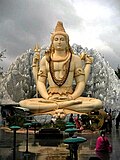바수데바-크리슈나
| 바수데바 | |
|---|---|
 | |
| 숭배 | 바가바타, 크리슈나파 |
| 무기 | 수다르샨차크라 카우모다키 |
| 출생 | 수라세나 마투라[4] |
| 부모 | 데바키 (모친) 바수데바 아난카둔두비 (부친) |
| 형제자매 | 상카르샤나 (형) 수바드라 (여동생) |
| 자녀 | 프라듐나, 삼바 |
| 힌두교 |
|---|
 |
바수데바(산스크리트어: वासुदेव), 후에 바수데바-크리슈나(Vāsudeva-Kṛṣṇa, "크리슈나, 바수데바의 아들")로 통합된[5][6][7] 크리슈나-바수데바 또는 간단히 크리슈나는 마투라 지역의 브리슈니족 왕 바수데바 아나카둔두비의 아들이었다.[8] 그는 브리슈니 영웅들의 주요 구성원이었고, 마투라 지역의 역사적인 지배자였을지도 모른다.[8][9][10][11]
바수데바교는 기원전 8세기에서 6세기 사이에 발생한 인도의 브라만교의 쇠퇴와 함께 생겨났다.[12] 바수데바는 인도에서 가장 초기 형태의 개인적인 신 숭배의 대상이 되었고, 이는 기원전 4세기경부터 증명된다.[13][14][15] 파니니의 글에 따르면 그 당시 바수데바는 이미 아르주나와 함께 등장하여 숭배의 대상으로 여겨졌는데, 파니니는 바수데바카가 바수데바의 신자(바크타)라고 설명하고 있기 때문이다.[16][17]
기원전 2세기 말, 바수데바는 헬리오도로스 기둥 비문에서 신화 속 새로 알려진 가루다를 상징하는 "신들의 신"인 데바데바로 여겨졌다.[18][19] 그리스 대사이자 헌신적인 헬리오도로스가 바친 이 기둥은 바수데바가 박트리아의 아가토클레스 (기원전 190–180) 주화에 그를 대표하기도 했던 인도-그리스인들로부터도 헌신을 받았다는 것을 보여준다. 지구, 우주, 하늘을 잇는 헬리오도로스 기둥은 "우주축"을 상징하고 신의 우주적 총체성을 표현하는 것으로 여겨진다.[18] 기둥 옆에서 바수데바의 큰 신전이 발견되었고, 그곳에서 그는 그의 신격화된 친족인 브리슈니 영웅들과 함께 경축되었다.[18]
바수데바에 대한 숭배는 나라야나, 슈리, 락슈미의 숭배와 함께 주요한 독립적인 숭배 종교 중 하나였으며, 나중에 연합하여 비슈나파를 형성했다.[1] 바수데바에 대한 숭배가 확립된 후, 브리슈니 부족은 크리슈나라는 이름의 그들만의 영웅신을 가진 야다바 부족과 융합되었다.[7] 초기 크리슈나는 마하바라타에서 알려져 있는데, 그곳에서 그는 드바라카의 야다바 왕국의 우두머리로 묘사된다.[7] 바수데바-크리슈나에 대한 융합된 숭배는 크리슈나파의 초기 역사의 중요한 전통들 중 하나가 되었고, 비슈누의 8번째 화신인 크리슈나에 대한 통합된 숭배의 주요한 구성 요소가 되었다.[9] 아바타라에 대한 비슈나파 교리에 따르면, 비슈누는 세상을 구하기 위해 다양한 형태를 취하며, 비슈데바-크리슈나는 이러한 형태들 중 하나이자 가장 인기 있는 형태들 중 하나로 이해된다.[20] 이 과정은 바수데바가 독립적인 신이었던 기원전 4세기부터 비슈누가 통합된 비슈나파 숭배의 중심 신으로 훨씬 더 두드러지는 4세기까지 지속되었으며, 이제 비슈데바-크리슈나는 그의 표현들 중 하나일 뿐이다.[20]
바수데바(Vāsudeva)는 비문 기록에 등장하는 최초의 이름이며, 파니니(Pāṇini)의 저술과 같은 초기 문헌 자료에 등장한다.[5] 바수데바가 정확히 크리슈나와 어떤 시점에 연관되었는지는 알려져 있지 않다.[21] 바수데바와 크리슈나라는 이름들 사이의 연관은 마하바라타와 하리밤사에서 나타나기 시작하는데, 이 둘은 서기 3세기에 완성된 마하바라타와 하리밤사에서 바수데바가 크리슈나의 수호신으로 등장하며, 그의 아버지는 이 글들에서 바수데바 아나카둔두비라고 불린다.[5] "바수데바-크리슈나"는 "바수데바의 아들 크리슈나"를 의미하며, "바수데바"는 긴 형태로 바수데바 아난카둔두비를 나타내는 짧은 형식 "바수데바"의 vṛddhi 파생어이다.[22]
같이 보기
[편집]각주
[편집]- ↑ 가 나 Singh, Upinder (2008). 《A History of Ancient and Early Medieval India: From the Stone Age to the 12th Century》 (영어). Pearson Education India. 436–438쪽. ISBN 978-81-317-1120-0.
- ↑ Osmund Bopearachchi, Emergence of Viṣṇu and Śiva Images in India: Numismatic and Sculptural Evidence, 2016.
- ↑ Srinivasan, Doris (1997). 《Many Heads, Arms, and Eyes: Origin, Meaning, and Form of Multiplicity in Indian Art》 (영어). BRILL. 215쪽. ISBN 978-90-04-10758-8.
- ↑ Raychaudhuri 1972, 124쪽
- ↑ 가 나 다 "While the earliest piece of evidence do not yet use the name Krsna...." in Austin, Christopher R. (2019). 《Pradyumna: Lover, Magician, and Son of the Avatara》 (영어). Oxford University Press. 23쪽. ISBN 978-0-19-005411-3.
- ↑ At the time of the Heliodorus pillar dedication to Vāsudeva in 115 BCE: "The real question, however, remains: was Vãsudeva already identified with Krsna?" Puskás, Ildikó (1990). “Magasthenes and the "Indian Gods" Herakles and Dionysos”. 《Mediterranean Studies》 2: 43. ISSN 1074-164X. JSTOR 41163978.
- ↑ 가 나 다 Flood, Gavin D. (1996). 《An Introduction to Hinduism》 (영어). Cambridge University Press. 119–120쪽. ISBN 978-0-521-43878-0.
- ↑ 가 나 Vāsudeva and Krishna "may well have been kings of this dynasty as well" in Rosenfield, John M. (1967). 《The Dynastic Arts of the Kushans》 (영어). University of California Press. 151–152 and Fig.51쪽.
- ↑ 가 나 Williams, Joanna Gottfried (1981). 《Kalādarśana: American Studies in the Art of India》 (영어). BRILL. 129쪽. ISBN 978-90-04-06498-0.
- ↑ Paul, Pran Gopal; Paul, Debjani (1989). “Brahmanical Imagery in the Kuṣāṇa Art of Mathurā: Tradition and Innovations”. 《East and West》 39 (1/4): 132–136, for the photograph p.138. ISSN 0012-8376. JSTOR 29756891.
- ↑ Smagur, Emilia. “Vaishnavite Influences in the Kushan Coinage, Notae Numismaticae- Zapiski Numizmatyczne, X (2015)” (영어): 67.
- ↑ "The theistic cult centered on bhakti for the deified Vṛṣṇi hero Vāsudeva, who is not mentioned in any early text. With the decline of Vedism, the cult emerged as a significant force. Strangely, the available evidence shows that the worship of Vāsudeva, and not that of Viṣṇu, marks the beginning of what we today understand by Vaiṣṇavism." in Eliade, Mircea; Adams, Charles J. (1987). 《The Encyclopedia of religion》 (영어). Macmillan. 168쪽. ISBN 978-0-02-909880-6.
- ↑ Doris Srinivasan (1997). 《Many Heads, Arms, and Eyes: Origin, Meaning, and Form of Multiplicity in Indian Art》. BRILL Academic. 211–220, 236쪽. ISBN 90-04-10758-4.
- ↑ Gavin D. Flood (1996). 《An Introduction to Hinduism》. Cambridge University Press. 119–120쪽. ISBN 978-0-521-43878-0.
- ↑ Christopher Austin (2018). Diana Dimitrova and Tatiana Oranskaia, 편집. 《Divinizing in South Asian Traditions》. Taylor & Francis. 30–35쪽. ISBN 978-1-351-12360-0.
- ↑ Malpan, Varghese (1992). 《A Comparative Study of the Bhagavad-gītā and the Spiritual Exercises of Saint Ignatius of Loyola on the Process of Spiritual Liberation》 (영어). Gregorian Biblical BookShop. 57–58쪽. ISBN 978-88-7652-648-0.
- ↑ "The affix vun comes in the sense of "this is his object of veneration" after the words 'Vâsudeva' and 'Arjuna'", giving Vâsudevaka and Arjunaka. Source: Aṣṭādhyāyī 2.0 Panini 4-3-98
- ↑ 가 나 다 《Approaches to Iconology》 (영어). Brill Archive. 1985. 41쪽. ISBN 978-90-04-07772-0.
- ↑ Malpan, Varghese (1992). 《A Comparative Study of the Bhagavad-gītā and the Spiritual Exercises of Saint Ignatius of Loyola on the Process of Spiritual Liberation》 (영어). Gregorian Biblical BookShop. 58쪽. ISBN 978-88-7652-648-0.
- ↑ 가 나 Curta, Florin; Holt, Andrew (2016). 《Great Events in Religion: An Encyclopedia of Pivotal Events in Religious History [3 volumes]》 (영어). ABC-CLIO. 271쪽. ISBN 978-1-61069-566-4.
- ↑ At the time of the Heliodorus pillar dedication to Vāsudeva in 115 BCE: "The real question, however, remains: was Vãsudeva already identified with Krsna?" Puskás, Ildikó (1990). “Magasthenes and the "Indian Gods" Herakles and Dionysos”. 《Mediterranean Studies》 2: 43. ISSN 1074-164X. JSTOR 41163978.
- ↑ Fortson (2004:116f)



